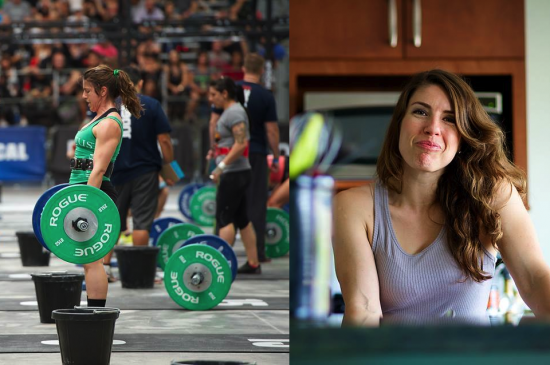Written by: Stephanie McCormack
Maybe you’re a hard-charging athlete with dreams of standing atop a CrossFit podium or being tops in a local race. Maybe you’re a weekend warrior pounding the pavement between hours at your day job, hoping for some sort of athletic advantage or boost in your training. Perhaps you’re after an aesthetic goal like leaning out or getting jacked with performance being secondary.
If you’re looking for an edge, there’s no doubt that nutrition is bound to be paramount in your mind. After all, there’s little debate at this point that you can out-train a suboptimal diet forever. No matter your group – performance- or aesthetics-driven – it’s easy to fall prey to the rookie (and sometimes not-so-rookie) mistake of piling several nutrition protocols on top of one another in the hopes that more equals better.
If you congregate with athletes, it won’t be long before you hear talk of fueling. Call it diet or nutrition, the conversation about what athletes consume in order to support training and recovery is bound to surface, and sometimes it goes like this:
Person 1: “How’s training going?”
Person 2: “Okay so far. I started eating cleaner lately, and it’s really helped.”
Person 1: “Oh yeah? What are you doing?”
Person 2: “Well, I’m intermittent fasting three times a week and carb-backloading for metcon days. I have dropped my calorie intake on rest days too.”
Person 1: “You’re really hitting all the angles then! Have you seen good progress? I should try it.”
In the best case scenario, person 1 proceeds to go online and learn the basics of carb-backloading, intermittent fasting and calorie restriction (or worse case, guesses) and attempts to apply it. None of these nutritional approaches are inherently bad; in fact, these and countless other existing protocols are neither good or bad and when applied correctly where appropriate, can prove effective. Rather, they have different – and highly potent – physiological consequences. When exercise protocols like endurance training, weightlifting programs and high-intensity exercise are mixed into these layered nutritional strategies, you end up with a recipe for something that’s undeniably complicated.
Essentially, you end up “eating in all directions”: taking such a multifaceted approach that it’s nearly impossible to tease out why something didn’t work (or did) because there are too many variables.
What might a day in the life of these “eating in all directions” athletes look like? They wake up on an intermittent fasting day and go all morning without eating only to hit the gym around noon on their lunch break. After a squatting session and a ten minute metcon afterward, they down a protein shake only after realize they forgot to bring the sweet potato from the refrigerator at home. It’s back to work for a couple hours then home in the evening. They try to eat as much as possible for dinner to make up for the light lunch and fasted morning, but it’s really difficult to make up for the caloric deficit. The athlete ends up having fasted for half the day, took a whack to their glycogen stores during the metcon, didn’t replace carbs post-workout, and is now hypocaloric for the day.
Why is it important, then, to eat in one direction? Perhaps this analogy from basic biology will help.
Predict which will grow taller: a fertilized or unfertilized plant. To start, plant a seed, one in each cup. Use the same type of soil and give each one the same amount of sunlight and water daily. After the seed sprouts, fertilize one but not the other. Every day for a week, measure the height of the plants.
Sounds pretty straightforward, right? Change one thing but keep everything else the same. Make observations and draw conclusions. If something doesn’t turn out the way you predicted, make an adjustment and try again. Repeat. This classic example of a basic controlled experiment makes it possible to figure out the effect of the one changed variable.
Now, what if you had the same experiment as the one above but you introduced several variables at the same time? Let’s say that in addition to fertilizing one, you also watered it more, exposed it to variations of sunlight, and put it in higher quality soil. If it does indeed grow taller than the unfertilized plant, how are you going to know which variable to attribute that extra growth to? See the problem with adding in multiple variables?
Applying that concept to nutrition should be pretty simple in theory: establish a plan, eat accordingly, observe and quantify the results. Make an adjustment if you don’t see the aesthetics or performance you’d like, and repeat the process. To put it another way, when you’re eating in all directions, how can you possibly know what to attribute success or failure to?
The obvious rebuttal to said analogy would be that it’s impossible for any single human to conduct a controlled experiment on themselves, reason being it’s not possible to have a parallel control group at the same time. While this is certainly valid, all that can be done is to minimize as many variables as possible until clear conclusions can be drawn. When layered, nutritional approaches can be confounding at best: clouded correlation, not causation is the best outcome you can hope for.
Training an athlete – nutrition included – is both a science and an art. Taking a systematic approach to the input and careful measurements of the output is what’ll get you the best results. The podium spot will follow.
Twelve years of science teaching experience, a certificate in holistic nutrition and an unabashed love of tasty Paleo food combine to fuel Steph’s passion for Stupid Easy Paleo. She went Paleo in early 2010, and it didn’t take long until she decided she was never turning back. Eating clean, nutrient-dense foods has fueled her both in life and as a competitive CrossFitter and mountain bike racer. She launched Stupid Easy Paleo in 2011 as a way to help spread the word about how to make simple, tasty recipes to help people in their quests to just eat real food.



Great article. When starting Paleo over a year ago I got on that n=1 treadmill. I have learned little that I am sure of but I have some better ideas now. I think it has made me a little more flexible on what I believe to be true. I enjoy questioning everything now. I try to get lots of sleep, meat, sunshine, exercise and aggressively pursue happiness.
Thanks for this article Steph. I am SOOOO guilty of the “gazillion-demiensional” approach – both in nutrition and training (think trying to cut significant weight, increase my strength and drastically improve my metcons, while getting little sleep, intermittant fasting and going SUPER LO CARB). Yup, you’re talking directly to me sista! Having slacked for almost a month (my house got hit by a tornado and choas followed), I am getting re-organized and back on track. I was debating a few different angles, but this article reminded me to keep it simple. Perfect timing. Keep up the good work everyone at RobbWolf.com !!
Our coach always says it’s nearly impossible to out train bad eating habits, my wife and I eat mostly paleo but many times getting stuck in a time crunch or going out to eat makes following a paleo diet rather difficult.
This is all a result of information overload. It’s so hard to find a single method and focus on it when you hear about the next greatest thing on(you pick the medium)tv, radio, internet, email… All the sales/marketing is so slick its hard not to pay attention!
Yes, yes, yes! INFORMATION OVERLOAD. I would add that it’s very hard to come up with a personal Paleo plan when opinions out here in the online Paleo world can differ from expert to expert, and even with one expert, from year to year. A Paleo newbie ends up thinking, “maybe if I add a pinch of this and a pinch of that, I’ll cover all my bases.” I guess the bottom line is, “eat real food.”
Stephanie, this is infact, terrible advice under the excuse of drowning in too much information.
Sorry, to disagree, but the whole point of biohacking is to learn what works by trying it, and using it. Part of that is just doing one thing at a time, but also tweaking that to learn what else can improve it, and logging and recording the results.
Sure, the first thing will get you maybe 50% of the way, but adding another can get you another 20%, and adding a third can get you another 15% on top of that, and so forth until you settle on a path that works well for you, and stick with it.
In fact, doing IF, or VLC with a carb backloading session after workouts works very well, at least for this n=1. In fact, if you actually bother to read the Carb backloading book, doing both IF/low carb along with the refeed are explicitly mentioned in that book. By putting “dude, I’m doing IF and carb-backloads” as your strawman arguement, you’re showing your ignorance of that particular book, which by definition should preclude you from commenting on its efficacy.
Sure, don’t fret over marginal things that will cost you a lot of time, effort, and money to get a 1% improvement, but, by all means test your hypotheses, and those of others, to see what it is that they can do for you, if you are so inclined. Retain those that make significant improvements in your life, and discard those that don’t. That’s the scientific, n=1, quantified-self/paleo-hacks way.
If you’re happy where you are, by all means, stop chasing improvement. If you’re not, bio-hack away, one thing at a time, and be sure to measure and record – that’s how you’ll know if something has a beneficial effect for you, or not.
As for forgetting to bring the sweet potato for a PWO in a fasted meal, that’s just pure dumb forgetfulness or a lack of attention, yes, it can happen, but you’re misusing it as a substantial example for your thesis in this article.
I may agree with your intended core thesis to test one thing at a time, but I disagree with the examples and advice you give, as that isn’t what they say at all, and detract from your message.
OK, so maybe the main example used isn’t the best, but it is nitpicking to suggest that this demolishes the quality of, and messages in the article.
Sticking to a plan instead of being diverted by the latest great idea, and methodically testing and evaluating any changes is the best way to go, as Steph suggests in this well-written article.
As I am considered as weekend warrior, I need to look into carefully about my nutrition consumption to get it right.
Thanks for the article, simply it has triggered me.